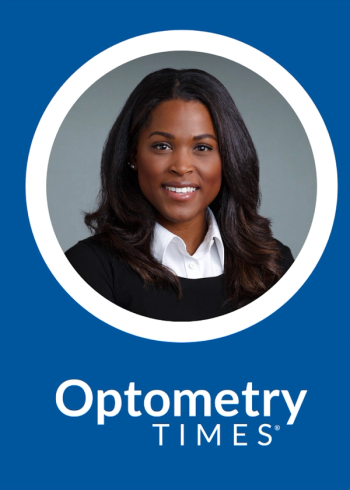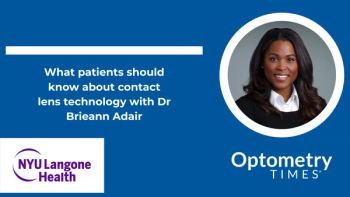
- May digital edition 2020
- Volume 12
- Issue 5
Engineer a specialty contact lens practice
Contact lens experts detail how to help more patients see better and deliver life-altering care.
Software engineers use the terms “front end” and “back end” to differentiate between the final user interface (front end) and the coded data (back end). The hardware contains the physical tools and infrastructure enabling the program to be processed and displayed. We can apply these same concepts to engineering a specialty contact lens (CL) practice.
Defining specialty CL practice
When we refer to a specialty CL practice, we are describing a practice that seeks to excel in and promote CLs as an exclusive niche, both clinically and financially. The clinical focus may be all encompassing or more narrow. A practitioner may choose CLs as a subspecialty and focus, for example, on presbyopia or pediatrics. Likewise, a clinic may serve a population of medically needy irregular cornea patients.
The definition does not imply that all lenses must be complex or custom designed. For example, a successful CL specialist might limit her fitting to soft CLs and still successfully serve a wide variety of patient needs.
Related:
ODs are aware of the increasing influence (both positive and negative) of disruptors in the market. These include online spectacles, online exams, and alternative sourcing of CLs products. Direct-to-consumer subscription services are available as well. Many of these disruptors seek to bypass professional optometric services.
Developing a Specialty Contact Lens Practice of Excellence ensures a loyal patient base, one which is, by necessity, less price sensitive. In the end, CL specialists not only help patients see better and deliver life-altering care, but we derive continued intellectual stimulation and re-energize ourselves and our staff with the professional rewards.
The back end
ODs need “data” to drive the specialty CL practice. First, develop an understanding of clinical indications for specialty CLs. Keep in mind that specialty lens fitting does not apply only to irregular corneas. Even “normal” corneas may benefit from custom-designed or extended-range soft CLs.
While the industry has seen a great expansion of available parameters in non-custom soft lenses, including daily disposables, CL fitters often see cases in which patients’ Rx needs fall outside these ranges. Even normal corneas cannot all be squeezed into conventional brands. Remember that sagittal depth comes into play with soft lens fitting, and horizontal visible iris diameter (HVID) is a better predictor of lens fit than central corneal curvature.1
When choosing CL modality for correcting astigmatism, it is important to distinguish between corneal toricity and internal (residual) cylinder. When designing toric gas permeable (GP) lenses, corneal cylinder exceeding 3.00 D will require a back surface toric or bitoric CL, and visually significant refractive cylinder in the presence of a spherical cornea will require a front surface toric design.2
Related:
Aspheric multifocal CLs, whether GP or soft, are the design of choice for most presbyopes, except for patients having no intermediate needs and high visual demand for a fixed near distance.3
Overnight orthokeratology (ortho-K) and myopia management are two fast-growing categories and represent opportunities for developing specialty services.4 The recent launch of an U.S. Food and Drug Administration (FDA-approved daily disposable center-distance multifocal design (MiSight, CooperVision) adds to previously available choices of off-label applications of an extended depth-of-field daily disposable, monthly replacement bifocals, and custom-designed planned replacement soft lenses. Overnight ortho-K offers the benefit of myopia control as well as the freedom from daytime visual correction and a reversible alternative to refractive surgery.
Medically necessary CLs aid in visual rehabilitation and provide critical surface protection for patients suffering from a wide range of anterior segment pathology, including corneal ectasia, post-surgical irregularity, corneal scarring, and a compromised tear film secondary to auto-immune disease. A practice’s “database” for this subspecialty should include a lens selection strategy.
Related:
Consider this proposed contact lens classification scheme:
- Corneal GP, custom soft, hybrid lenses for low to moderate irregularity with centered corneal apex
- Intralimbal or hybrid lenses for post-penetrating keratoplasty, post-filtration surgery, mild pellucid marginal degeneration.
- Hybrid or scleral lenses for greater corneal irregularity, greater lid sensitivity, challenging environments and lifestyle
The next level of the data set is fitting analytics. This includes diagnostic (“trial” fitting) and empirical (topography-based modules) analysis. With increased prescription of scleral lenses as well as overnight ortho-K lenses, the trend over the past several years has been toward empirical fitting. This has been supported by increased availability of topographic and surface profiling instruments that offer CL design software modules. Some are brand specific, and others are brand agnostic.
Empirical fitting “gets you there faster” by limiting the number of trial lenses and fitting sets, and allows fitters to visualize changes without multiple on-eye trials. It also reduces potential re-orders.
For blink-independent designs such as ortho-K, scleral CLs and, to a large degree, intralimbal designs, empirical fitting is very reliable. Empirical fitting software also facilitates rapid calculations for back surface toric corneal GP lenses.
Related:
Diagnostic skills, however, still must be relied upon for evaluation of suitability for dispensing as well as for troubleshooting. Trial lens assessment is helpful when fitting corneal GPs and custom soft designs to gauge patient tolerance and evaluate lens centration and movement with the blink.
Here is a recommended fitting set inventory:
- One well-configured spherical corneal GP fitting set in a 9.5 mm diameter
- For presbyopic GP fitting, a low-eccentricity back surface aspheric design that can incorporate additional add power on the front surface will accommodate most needs
- For mild corneal irregularity in post-refractive surgery or corneal transplant patients, one larger-diameter design (i.e., 10.4 mm) offering a reverse geometry profile is beneficial
- Hybrid fitting sets are available for both regular and irregular cornea patients
- Custom soft keratoconic fitting sets
Related:
The hardware
A solid foundation of specialty CL practice infrastructure includes clinical equipment and supplies, staff training protocols, and administrative procedures and tools.
Equipment considerations can be divided into basic tools and advanced technology. Necessary equipment is largely already found in a well-outfitted primary-care exam lane but should also include a topographer, V-gauge, loupes, a Burton lamp, and scleral lens inserters and removers. Advanced instrumentation to consider are a radiuscope, lens modification unit, anterior segment ocular coherence tomographer (OCT), scleral profiler, and confocal and or specular microscopes. Must-have accessories include CL cases, disinfecting and storage solutions, lens cleaners, removers and inserters, and table mirrors.
Delegating all procedures that can be performed outside of the exam room is the key to achieving the most proficient and profitable CL practice. Staff training protocols should develop conceptual, technical, and patient-communication skills. This includes:
- Proficiency and accuracy with instrumentation; ability to explain the why of testing
- Insertion and removal (I&R)
- Lens verification
- GP lens modification
- Patient training
- Topography and tomography: Knowledge of which maps are relevant to condition
- Follow-up examinations: Understanding how to handle patient complaints and assess compliance with care products and I&R techniques
- Phone triage: Knowledge of what constitutes an urgency or emergency, how to appropriately advise patients or direct their questions
Related:
The third cornerstone of your well-engineered specialty CL practice is comprised of the fee structure, the appointment template, lens ordering procedures, tracking and return protocols, and the written patient communications templates.
Your fee structure can be either “global” or “a la carte,” but in either case should yield proper return on investment for all materials and time spent with the patient inclusive of fitting, training, lenses, supplies, and follow-up care. Be sure to account for shipping and handling costs when setting your fees.
Regarding patient scheduling, here are tips for optimizing practice efficiency and profitability:
- Differentiate between comprehensive primary care exam and CL consultation regarding exam procedures and the corresponding fees
- Differentiate between CL consultation and the actual diagnostic evaluation
- If possible, do not use chair time for procedures that can be handled by a technician
- Work in other patients during all “fits”
- Schedule catch-up time or time to work in new patients or dispensing visits on any given day
Finally, draft and store templates for patient forms such as advance beneficiary notice (ABN), financial agreement, scleral lens consent form (Figure 1), myopia management/ortho-K consent forms and letter of medical necessity (Figure 2).(See article on website for downloadable figures.)
Related:
The front end
Through creative and resourceful front-end engineering, utilizing all forms of communication and media, ODs can convey their expertise, effectively educate current and potential new patients, and successfully build patient referrals.
Let’s break down these marketing efforts into internal marketing and external marketing.
Internal marketing
The most direct and personalized approach is to start right in the exam room with the patient in the chair. Providing a newly fitted or refitted patient with comprehensive oral and written instructions is paramount to patient success and will ensure affirmation of the OD’s superior care and expertise.
Here is a short checklist of patient management best practices:
- Prefitting: Summarize findings after comprehensive diagnostic evalution; describe two alternatives; explain the “first” choice; outline process
- Dispensing: Reassure patient that it is not “one and done;” establish time guidelines; be sure all questions and concerns are addressed; mention after-hours “support”
- Follow-up: Pre-appoint visits; post-dispensing call; update spectacles; perform any “postponed” tests; order spare lenses
Semi-annual or annual progress visits, even with a successful fit and happy patient, should never be merely “routine.” Remember the “humble brag” goes a long way. Remind patients of how complex their cases were and how pleased you are at the outcome. Try to bring up one or two new developments you are looking forward to discussing or providing to them in the future.
Related:
Additional important touch points include the reception desk and the waiting area. This can come in the form of office brochures (Figure 3) and copies of articles in publications written by the doctors. The literature should cover a range of topics related to specialty lenses, from myopia management to scleral lenses, and serve as excellent conversation starters in the exam room. These brochures go on to list indications, fitting process, and basic handling. Patients are a prime source of family and friend referrals and an ideal demographic to offer an update to newer technology.
External marketing
Consumers are constantly bombarded with a stream of digital marketing sent directly to their handheld devices. In order to succeed with building an online presence, employing efficient strategies can capture the next new patient and keep current patients invested in the practice’s services.
Reach within the practice’s internal patient base is limited, so taking the marketing approach online may cast a wider net. Most social media platforms such Twitter, Facebook, and Instagram are free to post on. Sponsoring posts to targeted groups, such as “emerging presbyopes” or “mothers in your neighborhood,” is a cost-effective way to utilize the marketing budget. Numerous platform management tools, such as Hootsuite and Buffer, will streamline the tedious task of multiple daily posts onto various channels. A main key of gaining a social media presence is persistence in posting, instead of a “set it and leave it” approach.5
Related:
Facebook Boost or sponsored posts are a cost-containing option in comparison to print ads. Digital Facebook advertising works within a budget to set parameters to reach a specific age range, gender, and ZIP code.6 Newspaper ads and alternative print ads are often much more expensive and require weekly repetition to truly gain traction.
One of the first impressions of the office is the practice website. It is imperative to make sure it is mobile-device friendly (optimized for mobile). In order to achieve search engine optimization (SEO), ensuring that the site appears high on the list of results through a search engine, list all available services. The addition of a blog or newsletter added in accordion pages can improve the ranking of the page in search engine results. This can include industry and professional journal publications.7
Google Reviews are a strong basis of internet referrals. Once the front desk staff confirms updated email address and mobile number for patients, they receive a direct link to write a review after completing their exams. The reviews then show up to the office-location–specific Google pages, linking real patients and their experiences in their own words with the office information directly alongside it.
Finally, referral sources from within the community are a tried-and-tested option to building a specialty contact lens practice. During calmer periods, meet with corneal specialists, pediatric ophthalmologists, cataract surgeons, pediatricians, and optometrists in various settings. Instead of setting up an appointment and taking up valuable time otherwise spent with their patients, call ahead to ensure the specific doctor is in that day. Stopping in during patient hours allows time for a brief encounter with the office manager and the doctor between patients regarding the services you can offer. Often, bringing literature such as the brochures mentioned in this article, as well as referral pad and business cards, will serve to remind the doctor when the next CL patient comes around. After a canvassing visit, we send a letter to summarize our discussion, and reiterate our promise to send the patient back for all other services.
Related:
References:
1. Young G. Ocular sagittal height and soft contact lens fit. J Brit Cont Lens Assoc. 1992;15(1):45-49.
2. Johnson MA. Bi-toric, Back Toric or Aspheric? Art Optical Consultant’s Corner. Available at: https://www.artoptical.com/storage/docs/Bi_toric__Back_Toric_or_Aspheric.pdf. Accessed 4/24/20.
3. Kitzman T, Lam J, Moore A, Lievens C. Fine-Tune Your Multifocal Lens Fitting. CL Spectrum. Available at: https://www.clspectrum.com/issues/2018/june-2018/fine-tune-your-multifocal-lens-fitting. Accessed 4/24/20.
4. Bennett ES. GP Annual Report 2019. CL Spectrum. Available at: https://www.clspectrum.com/issues/2019/october-2019/gp-annual-report-2019. Accessed 4/24/20.
5. NorCal Group. Social Media Tips for Medical Practices: A How-To Guide. Available at: https://www.norcal-group.com/library/social-media-tips-for-medical-practices-a-how-to-guide. Accessed 4/24/20.
6. Facebook. Create Boosted Posts. Available at: https://www.facebook.com/business/help/347839548598012?id=352109282177656. Accessed 4/24/20.
7. Hatter B. Five Marketing Steps Your Medical Practice Should be Taking. Phys Prac. Available at: https://www.physicianspractice.com/marketing/five-marketing-steps-your-medical-practice-should-be-taking. Accessed 4/24/20.
8. Markham MJ, Gentile D, Graham DL. Social Media for Networking, Professional Development, and Patient Engagement. Am Soc Clin Oncol Educ Book. 2017;37:782-787.
Articles in this issue
over 5 years ago
Key elements to know about MIPS in 2020over 5 years ago
Masquerading maculopathy: The importance of correct diagnosisover 5 years ago
Misdiagnosis when clinical findings don’t make senseover 5 years ago
How to differentiate CTK from DLK in post-surgical patientsover 5 years ago
Time in range as an alternative to HbA1cover 5 years ago
Elevate standard of care with artificial intelligenceover 5 years ago
Optometry’s Apollo 13 moment during COVID-19over 5 years ago
Telemedicine in the face of COVID-19Newsletter
Want more insights like this? Subscribe to Optometry Times and get clinical pearls and practice tips delivered straight to your inbox.













































.png)


